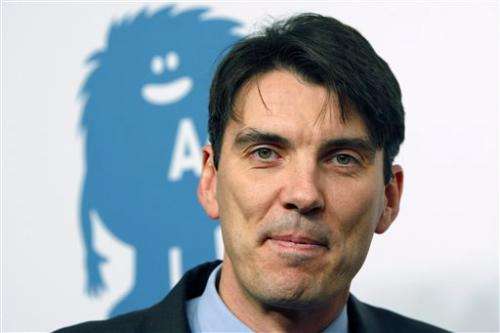Negatives aside, AOL CEO posts positive results (Update)

AOL chief executive Tim Armstrong isn't one to mince words. Over the weekend, he apologized for insensitive comments and backtracked from an unpopular plan to pay matching retirement fund contributions in a lump sum at the end of the year. Armstrong had previously defended the proposal by citing the high cost care for two "distressed babies" born to employee families.
It wasn't the first time Armstrong made headlines for appearing brusque and indifferent to employees. Last summer, he abruptly fired a high-ranking staffer during a meeting in which about 1,000 employees participated via conference call.
Why does Armstrong still have a job? Since taking charge in April 2009, he has revived an ailing company known for its 1990s era dial-up Internet service and its "You've got mail" slogan.
"The stock has tripled since 2012. From an investor perspective, the stuff Tim says they are going to do, he does," says John Blackledge, an analyst at Cowen & Co. What he's done with what he was given, he adds, "is excellent."
The former Google advertising chief was hired to supervise AOL's separation from Time Warner—a union that is widely viewed as one of the worst mergers in history. His next task: Oversee AOL's transformation from an Internet provider that subsists on subscription fees to a content company that makes most of its money from advertising. Although the work is still underway, he has largely succeeded.
"He certainly has taken AOL and moved it in a new direction," says Rita McGrath, professor of management at Columbia Business School. McGrath says, "from a shareholder perspective, he has stabilized the company. For a long time they were very lost."
McGrath adds that it's unlikely AOL's board will look to replace Armstrong any time soon, even with his human relations errors. Blackledge, meanwhile, thinks the headline-grabbing comments have "no bearing" on Armstrong's management of the business.
Here's a look at Armstrong's missteps and accomplishments:
— MINUS
Reaction to Armstrong's "distressed baby" comments, made during a conference call with employees, was swift. The mother of one of the babies wrote a heart-wrenching, yet measured response on Slate.com last weekend. Armstrong apologized and reinstated the old benefits plan in which the company matches employees' retirement fund contributions on a per pay period basis.
— PLUS
AOL recently recorded its strongest quarterly revenue growth in a decade. The company grew revenue by 13 percent in the final three months of 2013, to $679 million from $599.5 million in the same period the year before.
—PLUS
At around $45 per share this week, AOL's stock is up 80 percent since the company split from Time Warner in late 2009.
— MINUS
For the first few years under Armstrong, AOL was losing dial-up subscribers, as expected, but its ad revenue was falling. In a milestone reached in May 2011, AOL said revenue for display ads —billboard-like ads on websites—grew for the first time in three years. But overall ad sales were still down.
—PLUS
Three months later, AOL announced its advertising revenue grew for the first time since 2008 in what Armstrong called "another meaningful step forward in the comeback of the AOL brand."
— MINUS
In 2009, AOL bought Patch for $7 million. Two years earlier, Armstrong had co-founded the ambitious local news startup. In a 2010 interview with the Associated Press, Patch CEO Jon Brod said AOL sees local websites as the "largest commercial opportunity online that's yet to be won." For about an 18-month period in 2010 and 2011, Patch was the biggest hirer of journalists, just as they were being laid off from struggling U.S. newspapers. But Patch ran into the same problems newspapers had already discovered: It's expensive to cover local news. After pouring in tens of millions of dollars, AOL announced mass layoffs at Patch in August 2013 and said it was closing many of the local sites. In January 2014, AOL handed over operations of the troubled business to investment firm Hale Global.
— MINUS
In a meeting with Patch employees, Armstrong abruptly and publicly fired Patch creative director Abel Lenz for videotaping the meeting. According to reports at the time, Armstrong later apologized but did not hire Lenz back.
© 2014 The Associated Press. All rights reserved.



















